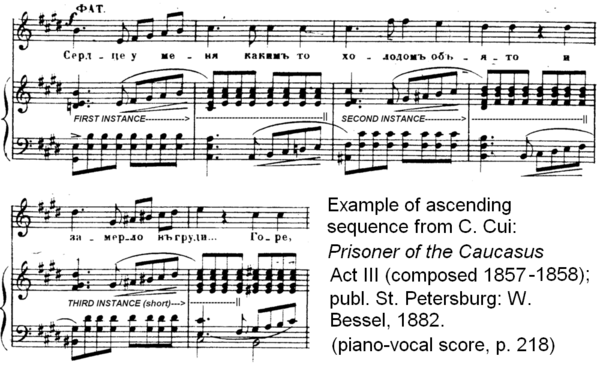- Sequence (music)
-
For the unrelated genre of Gregorian chant, see Sequence (poetry). For the means of triggering musical notes, see Music sequencer.
In music, a sequence is the immediate restatement of a motif or longer melodic (or harmonic) passage at a higher or lower pitch in the same voice.[1] It is one of the most common and simple methods of elaborating a melody in eighteenth and nineteenth century classical music[1] (Classical period (music) and Romantic music). Characteristics of sequences[1]:
- Two segments, usually no more than three or four
- Usually only one direction: continuingly higher or lower
- Segments continue by same interval distance
It is possible for melody or harmony to form a sequence without the other participating.
A real sequence is a sequence where the subsequent segments are exact transpositions of the first segment. A tonal sequence is a sequence where the subsequent segments are diatonic transpositions of the first segments. A modified sequence is a sequence where the subsequent segments are decorated or embellished so as to not destroy the character of the original segment. A false sequence is a literal repetition of the beginning of a figure and stating the rest in sequence.[1] A modulating sequence is a sequence that leads from one tonal center to the next, with each segment technically being in a different key in some sequences.[2]
A sequence can be described according to its direction (ascending or descending in pitch) and its adherence to the diatonic scale—that is, the sequence is diatonic if the pitches remain within the scale, or chromatic (or non-diatonic) if pitches outside of the diatonic scale are used and especially if all pitches are shifted by exactly the same interval (i.e., they are transposed). The non-diatonic sequence tends to modulate to a new tonality or to cause temporarily tonicisation.
At least two instances of a sequential pattern—including the original statement—are required to identify a sequence, and the pattern should be based on several melody notes or at least two successive harmonies (chords). Although stereotypically associated with Baroque music, and especially the music of Antonio Vivaldi, this device is widespread throughout Western music history.
The device of sequence epitomises both the goal-directed and the hierarchical nature of common-practice tonality. It is particularly prevalent in passages involving extension or elaboration; indeed, because of its inherently directed nature, it was (and still is) often pulled from the shelf by the less imaginative tonal composer as the stock response to a need for transitional or developmental activity. Whether dull or masterly, however, the emphasis is on the underlying process rather than the material itself.—Christopher Mark (2006), [3]Examples
A well-known popular example of a threefold descending diatonic sequence is found in the refrain from the Christmas carol "Angels We Have Heard on High," as illustrated immediately below. The one-measure melodic motive is shifted downward at the interval of a second, and the harmonic aspect does so likewise by following the circle of fifths:
The following three-fold ascending chromatic (non-diatonic) sequence occurs in the duet of Abubeker and Fatima from Act III of César Cui's opera Prisoner of the Caucasus (compare a similar passage in the famous Rodgers and Hammerstein song "Do-Re-Mi," composed almost exactly 100 years later):
Handel's "For Unto Us a Child is Born" (HWV 56) relies heavily on both melodic and harmonic sequencing, as can be seen in the following excerpt. In this vocal reduction, the soprano and alto lines reiterate a florid two-beat melodic motif for three and a half bars in a series of melodic sequences on the word "born." More subtle, though still present, are the underlying harmonic sequences.
See also
Sources
- ^ a b c d Benward and Saker (2003). Music: In Theory and Practice, Vol. I, p.111-12. Seventh Edition. ISBN 978-0-07-294262-0.
- ^ Benward and Saker (2003), Glossary, p.363.
- ^ Mark, Christopher (2006). "Tippett, Sequence, and Metaphor", Tippett Studies, p.96. Clarke, David, ed. ISBN 0521026830.
Categories:
Wikimedia Foundation. 2010.



